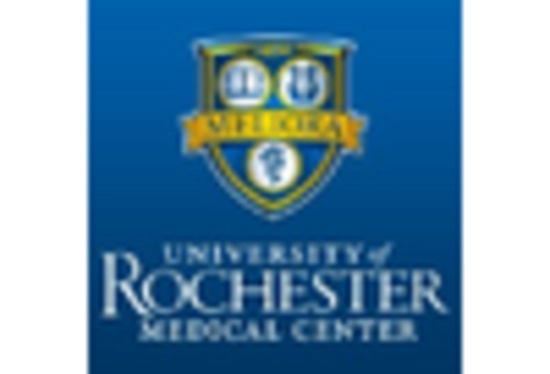Chemotherapy
Radiation Therapy
Targeted Therapy
Immunotherapy
Imaging Tests
Biopsy
Sputum Cytology
Blood Tests
Age
Gender
Smoking History
Geographic Location
Early Stage
Locally Advanced Stage
Metastatic Stage
North America
Europe
South America
Asia Pacific
Middle East and Africa
North America Outlook (USD Billion, 2019-2035)
North America Lung Cancer Market by Treatment Type
Chemotherapy
Radiation Therapy
Targeted Therapy
Immunotherapy
North America Lung Cancer Market by Diagnosis Type
Imaging Tests
Biopsy
Sputum Cytology
Blood Tests
North America Lung Cancer Market by Patient Demographics Type
Age
Gender
Smoking History
Geographic Location
North America Lung Cancer Market by Stage of Cancer Type
Early Stage
Locally Advanced Stage
Metastatic Stage
North America Lung Cancer Market by Regional Type
US
Canada
US Outlook (USD Billion, 2019-2035)
US Lung Cancer Market by Treatment Type
Chemotherapy
Radiation Therapy
Targeted Therapy
Immunotherapy
US Lung Cancer Market by Diagnosis Type
Imaging Tests
Biopsy
Sputum Cytology
Blood Tests
US Lung Cancer Market by Patient Demographics Type
Age
Gender
Smoking History
Geographic Location
US Lung Cancer Market by Stage of Cancer Type
Early Stage
Locally Advanced Stage
Metastatic Stage
CANADA Outlook (USD Billion, 2019-2035)
CANADA Lung Cancer Market by Treatment Type
Chemotherapy
Radiation Therapy
Targeted Therapy
Immunotherapy
CANADA Lung Cancer Market by Diagnosis Type
Imaging Tests
Biopsy
Sputum Cytology
Blood Tests
CANADA Lung Cancer Market by Patient Demographics Type
Age
Gender
Smoking History
Geographic Location
CANADA Lung Cancer Market by Stage of Cancer Type
Early Stage
Locally Advanced Stage
Metastatic Stage
Europe Outlook (USD Billion, 2019-2035)
Europe Lung Cancer Market by Treatment Type
Chemotherapy
Radiation Therapy
Targeted Therapy
Immunotherapy
Europe Lung Cancer Market by Diagnosis Type
Imaging Tests
Biopsy
Sputum Cytology
Blood Tests
Europe Lung Cancer Market by Patient Demographics Type
Age
Gender
Smoking History
Geographic Location
Europe Lung Cancer Market by Stage of Cancer Type
Early Stage
Locally Advanced Stage
Metastatic Stage
Europe Lung Cancer Market by Regional Type
Germany
UK
France
Russia
Italy
Spain
Rest of Europe
GERMANY Outlook (USD Billion, 2019-2035)
GERMANY Lung Cancer Market by Treatment Type
Chemotherapy
Radiation Therapy
Targeted Therapy
Immunotherapy
GERMANY Lung Cancer Market by Diagnosis Type
Imaging Tests
Biopsy
Sputum Cytology
Blood Tests
GERMANY Lung Cancer Market by Patient Demographics Type
Age
Gender
Smoking History
Geographic Location
GERMANY Lung Cancer Market by Stage of Cancer Type
Early Stage
Locally Advanced Stage
Metastatic Stage
UK Outlook (USD Billion, 2019-2035)
UK Lung Cancer Market by Treatment Type
Chemotherapy
Radiation Therapy
Targeted Therapy
Immunotherapy
UK Lung Cancer Market by Diagnosis Type
Imaging Tests
Biopsy
Sputum Cytology
Blood Tests
UK Lung Cancer Market by Patient Demographics Type
Age
Gender
Smoking History
Geographic Location
UK Lung Cancer Market by Stage of Cancer Type
Early Stage
Locally Advanced Stage
Metastatic Stage
FRANCE Outlook (USD Billion, 2019-2035)
FRANCE Lung Cancer Market by Treatment Type
Chemotherapy
Radiation Therapy
Targeted Therapy
Immunotherapy
FRANCE Lung Cancer Market by Diagnosis Type
Imaging Tests
Biopsy
Sputum Cytology
Blood Tests
FRANCE Lung Cancer Market by Patient Demographics Type
Age
Gender
Smoking History
Geographic Location
FRANCE Lung Cancer Market by Stage of Cancer Type
Early Stage
Locally Advanced Stage
Metastatic Stage
RUSSIA Outlook (USD Billion, 2019-2035)
RUSSIA Lung Cancer Market by Treatment Type
Chemotherapy
Radiation Therapy
Targeted Therapy
Immunotherapy
RUSSIA Lung Cancer Market by Diagnosis Type
Imaging Tests
Biopsy
Sputum Cytology
Blood Tests
RUSSIA Lung Cancer Market by Patient Demographics Type
Age
Gender
Smoking History
Geographic Location
RUSSIA Lung Cancer Market by Stage of Cancer Type
Early Stage
Locally Advanced Stage
Metastatic Stage
ITALY Outlook (USD Billion, 2019-2035)
ITALY Lung Cancer Market by Treatment Type
Chemotherapy
Radiation Therapy
Targeted Therapy
Immunotherapy
ITALY Lung Cancer Market by Diagnosis Type
Imaging Tests
Biopsy
Sputum Cytology
Blood Tests
ITALY Lung Cancer Market by Patient Demographics Type
Age
Gender
Smoking History
Geographic Location
ITALY Lung Cancer Market by Stage of Cancer Type
Early Stage
Locally Advanced Stage
Metastatic Stage
SPAIN Outlook (USD Billion, 2019-2035)
SPAIN Lung Cancer Market by Treatment Type
Chemotherapy
Radiation Therapy
Targeted Therapy
Immunotherapy
SPAIN Lung Cancer Market by Diagnosis Type
Imaging Tests
Biopsy
Sputum Cytology
Blood Tests
SPAIN Lung Cancer Market by Patient Demographics Type
Age
Gender
Smoking History
Geographic Location
SPAIN Lung Cancer Market by Stage of Cancer Type
Early Stage
Locally Advanced Stage
Metastatic Stage
REST OF EUROPE Outlook (USD Billion, 2019-2035)
REST OF EUROPE Lung Cancer Market by Treatment Type
Chemotherapy
Radiation Therapy
Targeted Therapy
Immunotherapy
REST OF EUROPE Lung Cancer Market by Diagnosis Type
Imaging Tests
Biopsy
Sputum Cytology
Blood Tests
REST OF EUROPE Lung Cancer Market by Patient Demographics Type
Age
Gender
Smoking History
Geographic Location
REST OF EUROPE Lung Cancer Market by Stage of Cancer Type
Early Stage
Locally Advanced Stage
Metastatic Stage
APAC Outlook (USD Billion, 2019-2035)
APAC Lung Cancer Market by Treatment Type
Chemotherapy
Radiation Therapy
Targeted Therapy
Immunotherapy
APAC Lung Cancer Market by Diagnosis Type
Imaging Tests
Biopsy
Sputum Cytology
Blood Tests
APAC Lung Cancer Market by Patient Demographics Type
Age
Gender
Smoking History
Geographic Location
APAC Lung Cancer Market by Stage of Cancer Type
Early Stage
Locally Advanced Stage
Metastatic Stage
APAC Lung Cancer Market by Regional Type
China
India
Japan
South Korea
Malaysia
Thailand
Indonesia
Rest of APAC
CHINA Outlook (USD Billion, 2019-2035)
CHINA Lung Cancer Market by Treatment Type
Chemotherapy
Radiation Therapy
Targeted Therapy
Immunotherapy
CHINA Lung Cancer Market by Diagnosis Type
Imaging Tests
Biopsy
Sputum Cytology
Blood Tests
CHINA Lung Cancer Market by Patient Demographics Type
Age
Gender
Smoking History
Geographic Location
CHINA Lung Cancer Market by Stage of Cancer Type
Early Stage
Locally Advanced Stage
Metastatic Stage
INDIA Outlook (USD Billion, 2019-2035)
INDIA Lung Cancer Market by Treatment Type
Chemotherapy
Radiation Therapy
Targeted Therapy
Immunotherapy
INDIA Lung Cancer Market by Diagnosis Type
Imaging Tests
Biopsy
Sputum Cytology
Blood Tests
INDIA Lung Cancer Market by Patient Demographics Type
Age
Gender
Smoking History
Geographic Location
INDIA Lung Cancer Market by Stage of Cancer Type
Early Stage
Locally Advanced Stage
Metastatic Stage
JAPAN Outlook (USD Billion, 2019-2035)
JAPAN Lung Cancer Market by Treatment Type
Chemotherapy
Radiation Therapy
Targeted Therapy
Immunotherapy
JAPAN Lung Cancer Market by Diagnosis Type
Imaging Tests
Biopsy
Sputum Cytology
Blood Tests
JAPAN Lung Cancer Market by Patient Demographics Type
Age
Gender
Smoking History
Geographic Location
JAPAN Lung Cancer Market by Stage of Cancer Type
Early Stage
Locally Advanced Stage
Metastatic Stage
SOUTH KOREA Outlook (USD Billion, 2019-2035)
SOUTH KOREA Lung Cancer Market by Treatment Type
Chemotherapy
Radiation Therapy
Targeted Therapy
Immunotherapy
SOUTH KOREA Lung Cancer Market by Diagnosis Type
Imaging Tests
Biopsy
Sputum Cytology
Blood Tests
SOUTH KOREA Lung Cancer Market by Patient Demographics Type
Age
Gender
Smoking History
Geographic Location
SOUTH KOREA Lung Cancer Market by Stage of Cancer Type
Early Stage
Locally Advanced Stage
Metastatic Stage
MALAYSIA Outlook (USD Billion, 2019-2035)
MALAYSIA Lung Cancer Market by Treatment Type
Chemotherapy
Radiation Therapy
Targeted Therapy
Immunotherapy
MALAYSIA Lung Cancer Market by Diagnosis Type
Imaging Tests
Biopsy
Sputum Cytology
Blood Tests
MALAYSIA Lung Cancer Market by Patient Demographics Type
Age
Gender
Smoking History
Geographic Location
MALAYSIA Lung Cancer Market by Stage of Cancer Type
Early Stage
Locally Advanced Stage
Metastatic Stage
THAILAND Outlook (USD Billion, 2019-2035)
THAILAND Lung Cancer Market by Treatment Type
Chemotherapy
Radiation Therapy
Targeted Therapy
Immunotherapy
THAILAND Lung Cancer Market by Diagnosis Type
Imaging Tests
Biopsy
Sputum Cytology
Blood Tests
THAILAND Lung Cancer Market by Patient Demographics Type
Age
Gender
Smoking History
Geographic Location
THAILAND Lung Cancer Market by Stage of Cancer Type
Early Stage
Locally Advanced Stage
Metastatic Stage
INDONESIA Outlook (USD Billion, 2019-2035)
INDONESIA Lung Cancer Market by Treatment Type
Chemotherapy
Radiation Therapy
Targeted Therapy
Immunotherapy
INDONESIA Lung Cancer Market by Diagnosis Type
Imaging Tests
Biopsy
Sputum Cytology
Blood Tests
INDONESIA Lung Cancer Market by Patient Demographics Type
Age
Gender
Smoking History
Geographic Location
INDONESIA Lung Cancer Market by Stage of Cancer Type
Early Stage
Locally Advanced Stage
Metastatic Stage
REST OF APAC Outlook (USD Billion, 2019-2035)
REST OF APAC Lung Cancer Market by Treatment Type
Chemotherapy
Radiation Therapy
Targeted Therapy
Immunotherapy
REST OF APAC Lung Cancer Market by Diagnosis Type
Imaging Tests
Biopsy
Sputum Cytology
Blood Tests
REST OF APAC Lung Cancer Market by Patient Demographics Type
Age
Gender
Smoking History
Geographic Location
REST OF APAC Lung Cancer Market by Stage of Cancer Type
Early Stage
Locally Advanced Stage
Metastatic Stage
South America Outlook (USD Billion, 2019-2035)
South America Lung Cancer Market by Treatment Type
Chemotherapy
Radiation Therapy
Targeted Therapy
Immunotherapy
South America Lung Cancer Market by Diagnosis Type
Imaging Tests
Biopsy
Sputum Cytology
Blood Tests
South America Lung Cancer Market by Patient Demographics Type
Age
Gender
Smoking History
Geographic Location
South America Lung Cancer Market by Stage of Cancer Type
Early Stage
Locally Advanced Stage
Metastatic Stage
South America Lung Cancer Market by Regional Type
Brazil
Mexico
Argentina
Rest of South America
BRAZIL Outlook (USD Billion, 2019-2035)
BRAZIL Lung Cancer Market by Treatment Type
Chemotherapy
Radiation Therapy
Targeted Therapy
Immunotherapy
BRAZIL Lung Cancer Market by Diagnosis Type
Imaging Tests
Biopsy
Sputum Cytology
Blood Tests
BRAZIL Lung Cancer Market by Patient Demographics Type
Age
Gender
Smoking History
Geographic Location
BRAZIL Lung Cancer Market by Stage of Cancer Type
Early Stage
Locally Advanced Stage
Metastatic Stage
MEXICO Outlook (USD Billion, 2019-2035)
MEXICO Lung Cancer Market by Treatment Type
Chemotherapy
Radiation Therapy
Targeted Therapy
Immunotherapy
MEXICO Lung Cancer Market by Diagnosis Type
Imaging Tests
Biopsy
Sputum Cytology
Blood Tests
MEXICO Lung Cancer Market by Patient Demographics Type
Age
Gender
Smoking History
Geographic Location
MEXICO Lung Cancer Market by Stage of Cancer Type
Early Stage
Locally Advanced Stage
Metastatic Stage
ARGENTINA Outlook (USD Billion, 2019-2035)
ARGENTINA Lung Cancer Market by Treatment Type
Chemotherapy
Radiation Therapy
Targeted Therapy
Immunotherapy
ARGENTINA Lung Cancer Market by Diagnosis Type
Imaging Tests
Biopsy
Sputum Cytology
Blood Tests
ARGENTINA Lung Cancer Market by Patient Demographics Type
Age
Gender
Smoking History
Geographic Location
ARGENTINA Lung Cancer Market by Stage of Cancer Type
Early Stage
Locally Advanced Stage
Metastatic Stage
REST OF SOUTH AMERICA Outlook (USD Billion, 2019-2035)
REST OF SOUTH AMERICA Lung Cancer Market by Treatment Type
Chemotherapy
Radiation Therapy
Targeted Therapy
Immunotherapy
REST OF SOUTH AMERICA Lung Cancer Market by Diagnosis Type
Imaging Tests
Biopsy
Sputum Cytology
Blood Tests
REST OF SOUTH AMERICA Lung Cancer Market by Patient Demographics Type
Age
Gender
Smoking History
Geographic Location
REST OF SOUTH AMERICA Lung Cancer Market by Stage of Cancer Type
Early Stage
Locally Advanced Stage
Metastatic Stage
MEA Outlook (USD Billion, 2019-2035)
MEA Lung Cancer Market by Treatment Type
Chemotherapy
Radiation Therapy
Targeted Therapy
Immunotherapy
MEA Lung Cancer Market by Diagnosis Type
Imaging Tests
Biopsy
Sputum Cytology
Blood Tests
MEA Lung Cancer Market by Patient Demographics Type
Age
Gender
Smoking History
Geographic Location
MEA Lung Cancer Market by Stage of Cancer Type
Early Stage
Locally Advanced Stage
Metastatic Stage
MEA Lung Cancer Market by Regional Type
GCC Countries
South Africa
Rest of MEA
GCC COUNTRIES Outlook (USD Billion, 2019-2035)
GCC COUNTRIES Lung Cancer Market by Treatment Type
Chemotherapy
Radiation Therapy
Targeted Therapy
Immunotherapy
GCC COUNTRIES Lung Cancer Market by Diagnosis Type
Imaging Tests
Biopsy
Sputum Cytology
Blood Tests
GCC COUNTRIES Lung Cancer Market by Patient Demographics Type
Age
Gender
Smoking History
Geographic Location
GCC COUNTRIES Lung Cancer Market by Stage of Cancer Type
Early Stage
Locally Advanced Stage
Metastatic Stage
SOUTH AFRICA Outlook (USD Billion, 2019-2035)
SOUTH AFRICA Lung Cancer Market by Treatment Type
Chemotherapy
Radiation Therapy
Targeted Therapy
Immunotherapy
SOUTH AFRICA Lung Cancer Market by Diagnosis Type
Imaging Tests
Biopsy
Sputum Cytology
Blood Tests
SOUTH AFRICA Lung Cancer Market by Patient Demographics Type
Age
Gender
Smoking History
Geographic Location
SOUTH AFRICA Lung Cancer Market by Stage of Cancer Type
Early Stage
Locally Advanced Stage
Metastatic Stage
REST OF MEA Outlook (USD Billion, 2019-2035)
REST OF MEA Lung Cancer Market by Treatment Type
Chemotherapy
Radiation Therapy
Targeted Therapy
Immunotherapy
REST OF MEA Lung Cancer Market by Diagnosis Type
Imaging Tests
Biopsy
Sputum Cytology
Blood Tests
REST OF MEA Lung Cancer Market by Patient Demographics Type
Age
Gender
Smoking History
Geographic Location
REST OF MEA Lung Cancer Market by Stage of Cancer Type
Early Stage
Locally Advanced Stage
Metastatic Stage









Leave a Comment